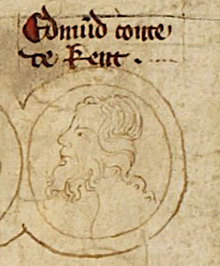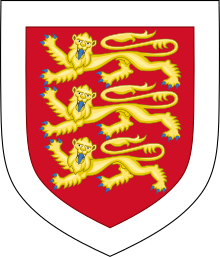
Back إدموند من ووستودك، إيرل كينت الأول Arabic ادموند من ووستودك ايرل كينت الاول ARZ Edmund z Woodstocku, 1. hrabě z Kentu Czech Edmund of Woodstock, 1. Earl of Kent German Εδμόνδος του Γούντστοκ, 1ος κόμης του Κεντ Greek Edmundo de Woodstock Spanish Edmond de Woodstock French Edmund dari Woodstock, Earl Kent pertama ID Edmondo Plantageneto, I conte di Kent Italian Едмунд (Прв Ерл од Кент) Macedonian
| Edmund of Woodstock | |
|---|---|
 | |
| Earl of Kent | |
| Reign | 26 July 1321 – 19 March 1330 |
| Successor | Edmund, 2nd Earl of Kent |
| Born | 5 August 1301 Woodstock, Oxfordshire |
| Died | 19 March 1330 (aged 28) Winchester Castle |
| Burial | |
| Spouse | Margaret Wake, 3rd Baroness Wake of Liddell |
| Issue | Edmund, 2nd Earl of Kent Margaret of Kent , Margaret, Viscountess of Tartas Joan of Kent John, 3rd Earl of Kent |
| House | Plantagenet |
| Father | Edward I of England |
| Mother | Margaret of France |

Edmund of Woodstock, 1st Earl of Kent (5 August 1301 – 19 March 1330), whose seat was Arundel Castle in Sussex,[1] was the sixth son of King Edward I of England, and the second by his second wife Margaret of France, and was a younger half-brother of King Edward II. Edward I had intended to make substantial grants of land to Edmund, but when the king died in 1307, Edward II refused to respect his father's intentions, mainly due to his favouritism towards Piers Gaveston. Edmund remained loyal to his brother, and in 1321 he was created Earl of Kent. He played an important part in Edward's administration as diplomat and military commander and in 1321–22 helped suppress a rebellion.
Discontent against the King grew and eventually affected Edmund. The discontent was largely caused by Edward's preference for his new favourites, Hugh Despenser the Younger and his father. In 1326, Edmund joined a rebellion led by Queen Isabella and Roger Mortimer, whereby King Edward II was deposed. Edmund failed to get along with the new administration, and in 1330 he was caught planning a new rebellion and executed.
Once the new king, Edward III, came of age and assumed personal control of the government, he posthumously annulled the charges against his uncle. The title and estates of the Earl of Kent descended on Edmund's son, also called Edmund. When this Edmund died, in 1331, his brother John became earl. Though he was officially exonerated, Edmund did not enjoy a great reputation during his life and afterwards, due to his unreliable political dealings.
- ^ Edmund FitzAlan, 9th Earl of Arundel of Arundel Castle was executed in 1326 for his part in the rebellion against King Edward II, whereupon Arundel Castle was forfeited to the crown, and was granted by Edward II to his half-brother Edmund of Woodstock
© MMXXIII Rich X Search. We shall prevail. All rights reserved. Rich X Search